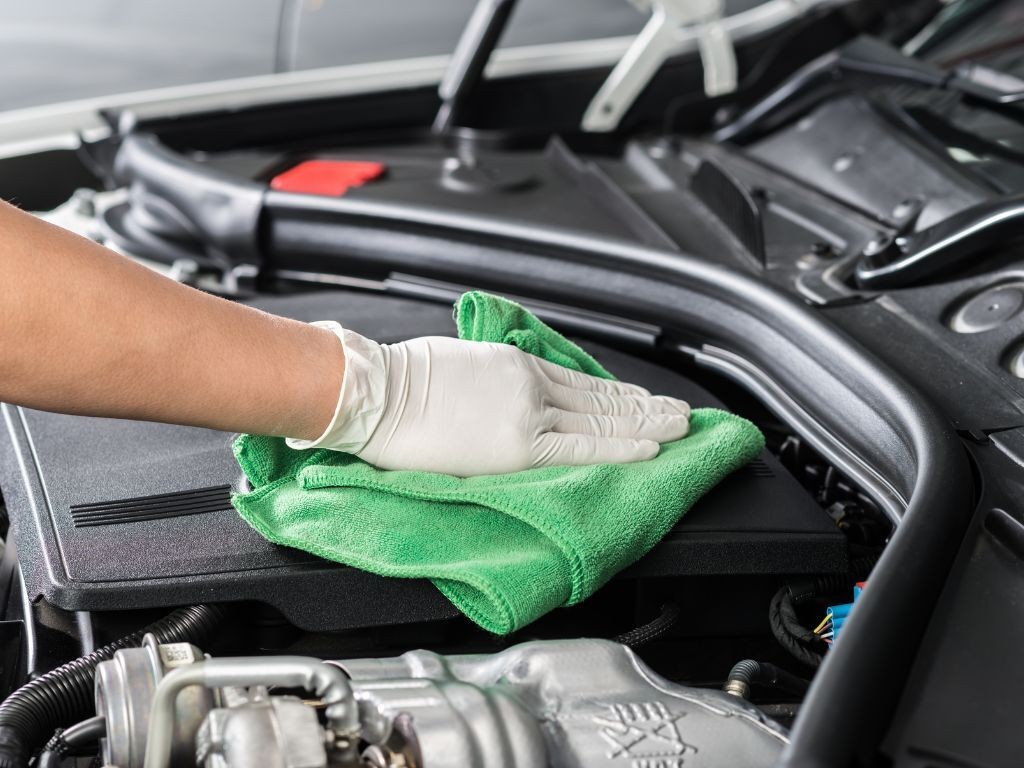Your car’s engine bay, often hidden beneath the hood, is the heart of your vehicle. It houses the engine, battery, transmission components, and a network of other essential parts that work in harmony to keep you moving. However, this critical area is frequently overlooked when it comes to cleaning and maintenance. Over time, the engine bay can accumulate dirt, grime, grease, leaves, and road debris, creating an unsightly mess and potentially leading to corrosion or even component failure.
But fear not! Cleaning under the hood of your car is a straightforward process that you can easily accomplish at home with the right tools and a bit of elbow grease. This guide will walk you through each step, ensuring you not only achieve a sparkling clean engine bay but also do it safely and effectively. Let’s dive into how to clean under the hood of your car and restore that factory-fresh look.
Step 1: Gather Your Supplies and Ensure the Engine is Cool
Before you begin, preparation is key. Working on a hot engine is dangerous and can cause burns, so the very first step is to ensure your engine is completely cool. Allow your car to sit for at least 30 minutes after driving to ensure the engine has cooled down sufficiently.
Next, gather all the necessary supplies. Having everything at hand will streamline the cleaning process. Here’s what you’ll need:
- Protective Gloves: To protect your hands from degreasers and grime.
- Eye Protection: Safety glasses or goggles to shield your eyes from splashes and debris.
- Brush Set: A variety of brushes, including a stiff-bristled brush for general scrubbing and detailing brushes for tighter spots.
- Vacuum Cleaner or Blower: To remove loose debris like leaves and dust. A vacuum with a hose attachment is ideal.
- Plastic Bags or Plastic Wrap: To cover and protect sensitive electrical components.
- Engine Degreaser: Choose a quality engine degreaser formulated for automotive use.
- All-Purpose Cleaner (Optional): For less greasy areas or for a final touch-up.
- Pressure Washer or Garden Hose with Spray Nozzle: For rinsing away the cleaning solutions and grime. A pressure washer should be used on a low setting. A steamer can also be effective.
- Microfiber Towels: Plenty of clean microfiber towels for drying and wiping down surfaces.
- Water Source: A bucket of clean water can be useful in addition to a hose.
Having these supplies ready will make the process efficient and ensure you have everything you need to do a thorough job of cleaning under the hood of your car.
Step 2: Remove Loose Debris
With your engine cool and supplies ready, the next step is to remove any loose dirt, leaves, and debris from the engine bay. This initial step makes the subsequent cleaning stages more effective.
Use a vacuum cleaner with a hose attachment or a blower to remove leaves, twigs, and loose dust. Pay attention to areas around the windshield cowl, near the battery, and in any crevices where debris might accumulate. Be gentle when vacuuming around delicate components to avoid dislodging anything. For larger debris, you can often remove it by hand, wearing your gloves.
Removing this initial layer of dry debris will prevent it from turning into mud when you introduce cleaning liquids, making the overall cleaning process much easier and more effective.
Step 3: Disconnect the Battery and Protect Sensitive Components
Safety is paramount when cleaning your engine bay. Before introducing any liquids, it’s crucial to disconnect the car battery to prevent electrical shorts and protect yourself from potential shocks.
Locate the negative terminal of your car battery – it’s usually marked with a minus (-) sign and is often black. Use a wrench to loosen the nut on the negative terminal and carefully disconnect the cable. Tuck the cable aside to ensure it doesn’t accidentally reconnect during cleaning. Some experts recommend disconnecting both terminals for added safety, starting with the negative and then the positive. If you’re unsure, disconnecting the negative terminal is generally sufficient for this task.
Once the battery is disconnected, identify sensitive electrical components in your engine bay. These typically include:
- The Car Battery (if not removed): Although disconnected, it’s best to keep it dry.
- Distributor (if applicable on older cars): Very sensitive to moisture.
- Engine Control Unit (ECU): The car’s computer, usually a black box with wiring harnesses connected to it.
- Alternator: While somewhat sealed, it’s best to avoid direct spraying.
- Air Intake: Prevent water from entering the air intake system.
- Exposed Wiring and Connectors: Any visible wiring or electrical connectors should be protected.
Cover these components with plastic bags or plastic wrap, securing them with tape if needed. This protective layer will prevent water and degreaser from directly contacting these sensitive parts, minimizing the risk of damage.
Step 4: Apply Degreaser and Agitate Grime
Now it’s time to tackle the grease and grime that has accumulated in your engine bay. Apply engine degreaser to the dirty areas, focusing on greasy spots and areas with built-up grime. Start with the underside of the hood, as this area often accumulates dirt and grease.
Spray the degreaser liberally but avoid soaking electrical connectors, even if they are covered. Let the degreaser dwell for the time recommended on the product label – usually a few minutes. This dwell time allows the degreaser to break down the grease and grime effectively.
After the degreaser has dwelled, use your brushes to agitate the grime. A stiff-bristled brush is excellent for general areas, while detailing brushes are perfect for reaching into tight corners, around hoses, and intricate engine parts. Scrub gently but firmly to loosen the dirt and grease. For plastic and rubber parts, a softer brush may be preferable to avoid scratching.
Work in sections, applying degreaser, agitating with brushes, and then moving to the next area. This systematic approach ensures you don’t miss any spots and allows the degreaser to remain effective. For particularly stubborn grime, you may need to reapply degreaser and scrub again.
Step 5: Rinse and Dry Thoroughly
Once you’ve degreased and scrubbed the entire engine bay, it’s time to rinse away the cleaning solutions and loosened grime. You can use a pressure washer on its lowest setting or a garden hose with a spray nozzle.
Important: Avoid direct, high-pressure spraying of sensitive components, even those that are covered. Use a wider spray pattern and maintain a safe distance. Focus the water stream on rinsing away the degreaser and grime. Work from top to bottom, allowing gravity to help carry the dirt away.
After rinsing, use clean microfiber towels to dry all surfaces thoroughly. Pay close attention to drying electrical connectors, spark plug areas, and any areas where water might pool. Compressed air can be helpful to blow water out of hard-to-reach crevices. Ensure the engine bay is as dry as possible to prevent water spots and corrosion.
Step 6: Reconnect the Battery and Final Touches
With the engine bay clean and dry, it’s time to reconnect the car battery. Locate the positive terminal (usually marked with a plus (+) sign and often red) and then the negative terminal. Reconnect the positive cable first, then the negative cable, ensuring the connections are secure. Tighten the nuts snugly but avoid over-tightening.
Before starting your car, double-check that all tools, cloths, and plastic coverings have been removed from the engine bay. Inspect for any loose wires or hoses that may have been disturbed during cleaning and ensure everything is properly positioned.
Finally, start your engine and let it run for a few minutes. This will help to evaporate any residual moisture and ensure everything is functioning correctly. Take a moment to admire your newly cleaned engine bay!
Maintaining a Clean Engine Bay
Cleaning your engine bay is a rewarding task, but keeping it clean is an ongoing effort. Here are some tips to maintain a spotless engine bay for longer:
Regular Car Washes
Regularly washing your car, including the exterior and undercarriage, helps to minimize the amount of dirt and debris that can find its way into the engine bay.
Garage Parking or Protective Coverings
Parking your car in a garage or using a car cover when parked outdoors shields the engine bay from environmental elements like rain, dust, and falling leaves.
Professional Detailing
Consider getting your car professionally detailed periodically. Professional detailers have specialized tools and products to thoroughly clean and protect all aspects of your vehicle, including the engine bay. They can also apply protectants to make future cleaning easier.
Spot Cleaning
Periodically check your engine bay for any new accumulations of dirt or spills. Spot cleaning these areas promptly with a damp cloth or a mild all-purpose cleaner can prevent grime from building up and keep your engine bay looking cleaner for longer.
Final Thoughts
Cleaning under the hood of your car is a simple yet impactful maintenance task that any car owner can undertake. A clean engine bay not only enhances your car’s overall appearance but also allows for easier identification of leaks or potential problems, and can even contribute to better engine cooling by removing insulating layers of dirt. By following these steps and incorporating regular maintenance habits, you can keep your engine bay looking its best and contribute to the longevity and performance of your vehicle. Enjoy the satisfaction of a clean and well-maintained engine bay!

